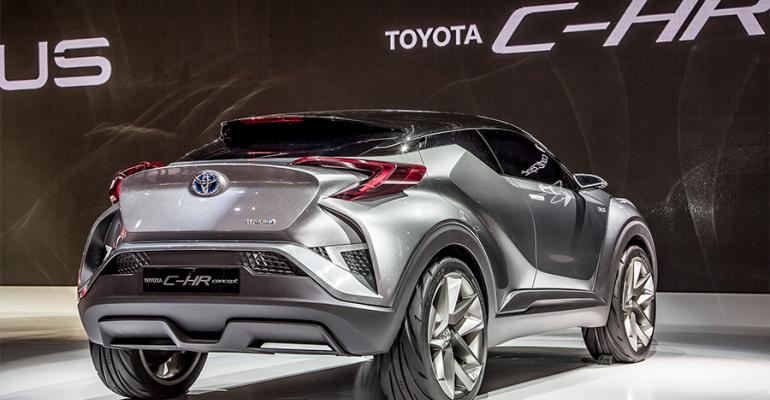SOPHIA ANTIPOLIS, France – Toyota opens the door on its new C-HR compact CUV to reveal the first views of its European-designed interior features.
First seen in Paris in 2014, the C-HR (coupe-high rider) introduces Toyota’s “Sensual Tech” design language touting a combination of high-technology features with a “sensual and fashionable style.”
The cabin is designed to be driver-focused while providing an airy yet warm and welcoming environment created by a wide, flowing piano-black instrument panel.
All the switchgear and the 8-in. (20-cm) touchscreen for the Toyota Touch 2 multimedia system are angled slightly toward the driver. The touchscreen is raised over the instrument panel rather than being enclosed by it and the upper dash is kept low to improve forward vision for the driver.
A 2-tiered front-seat combines a slender, sporting upper section with a more strongly bolstered and supportive lower area, a hybrid design emphasized by the use of differing tones, textures and patterns within the upholstery.
The C-HR’s interior is the work of Toyota’s European SQ team on the Cotes d’Azur in France working closely with the headquarters design team to maintain the original interior styling concept.
Many switches use a similar shape, reflecting the diamond motif of the exterior body shell. The same diamond theme is employed in the door-trim pattern, headliner, JBL audio speaker grilles, tweeter shape and the needles of the analog instrument dials.
Three main interior surface finishes are used, including a leather-like finish for background surfaces, a smooth Nappa grain for touch surfaces and technical grain for functional elements such as switchgear.
Decorative elements are finished in piano-black and satin-silver trim, and the clear blue instrument and switchgear illumination is fine-tuned to ensure consistency of hue.
Within the C-HR range, the interior will be available in a choice of three color schemes: dark gray, black/blue and black/brown, depending on specification and grade chosen.
This production car closely follows the concept car’s exterior and measures 172 ins. (4,360 mm) long, 71 ins. (1,795 mm) wide and 61 ins. (1,555 mm) high, in hybrid form, and has a 105-in. (2,640-mm) wheelbase.
The car gets its coupe looks from styling cues including a blacked-out rocker panel that flows toward the front and rear wheels and a shoulder crease that runs through to the front and rear. Other coupe signatures include rear-door handles hidden in the D-pillar and a sweeping roofline that merges into a large, aerodynamic, skeleton-frame rear spoiler.
At the back, the tapered cabin culminates in a top-hinged tailgate while the pronounced flaring of the wheel arches adds to the muscular look.
“The C-HR gives Toyota a powerful new presence in the growing C-crossover segment,” Kazuhiko Isawa, chief designer-C-HR, says in a statement. “It is intended to spearhead a new movement within its segment; to create a new frontier. That’s why we decided it had to be unique, with its own personality, full of originality.”
Orders will be taken in Europe in the fall with the first deliveries to customers at the start of 2017. Toyota expects sales of the C-HR, which sits between the Auris Touring Sports wagon and the RAV4 SUV in its range, to exceed 100,000 in the first year of production.





